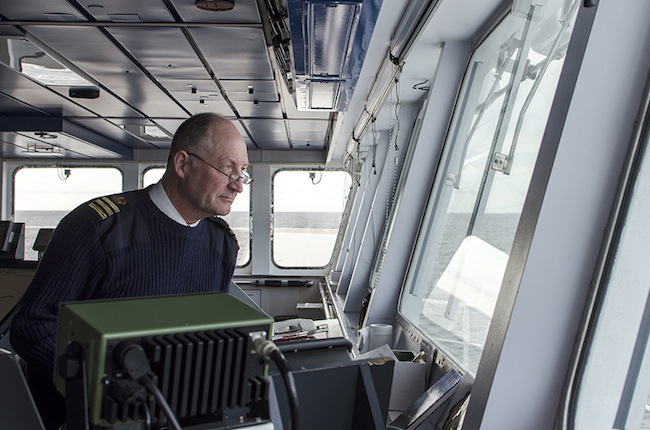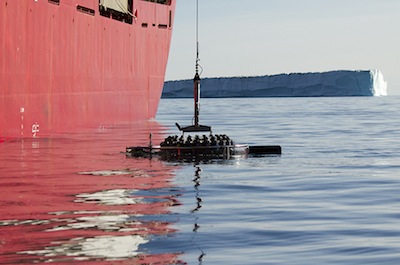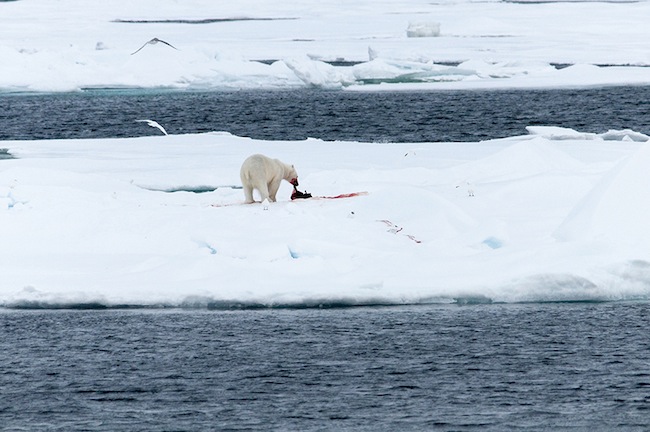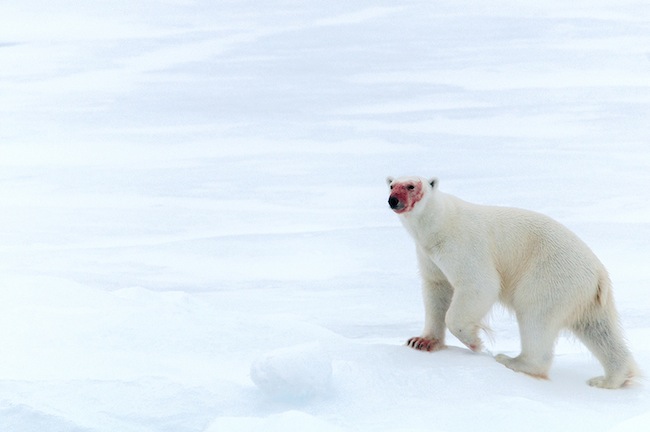31st August 2012
A northerly blew up overnight, not much over 28 knots, hardly worth mentioning except that it’s heftiest velocity we’ve seen so far. We were running to windward at 14 knots in open water to reach the last line at 77°30’ N. That speed, which burns a lot more fuel than the normal 11.5 knots, was a tribute to Bob (the Chief Mate just told me so), because he’s an excellent chief scientist who evinces respect and regard for all aboard, though he’ll probably ask me to cut these words. Before breakfast we’d turned left to a heading of 270°, and before lunch we were again lurching through thick sea ice, easily 9/10s coverage, at barely two knots.
(During lunch, the Captain came on the horn to announce that a polar bear was away three points off the starboard bow. En masse, we abandoned our chocolate mousse and bolted topside. It was a young male, I think, ambling over the ice trying, like us, to make his way in his frozen jurisdiction 90 miles from the nearest land.)
Bob is skeptical we’ll be able to complete the new CTD line in this, the thickest ice we’ve seen so far. “Maybe we’ll get in one cast,” he said as we passed on the stairs. Speaking of which, the other day when discussing the CTD and its data return, I neglected to mention its water-sampling function. Temperature and salinity measurements are sufficient to distinguish between the two parts (shallow and deep) of the East Greenland Current (EGC) and thus follow their tracks. To learn what he and Kjetil want to know, they need not measure, say, the specific chemical and nutrient components of the freshwater flushing out of the Arctic. Laura and Mirjam, however, want more finely grained data about the water itself. For that, they need to collect water in those thin gray “Niskin” bottles. Their spring-loaded caps must remain open on the downcast or increasing pressure would crush them flat, but at predetermined depths on the upcast, the CTD watch keepers “fire” the bottles with a mouse click on the control-room computer, and the caps snap closed, capturing a water sample for analysis.
Laura, an EGC expert from NIOZ in the Netherlands, measures the oxygen isotopes in the water samples in order to distinguish sea ice melt from so-called “meteoric water,” -that is, water originating from precipitation, glacial runoff, and the Siberian rivers (the salt content in sea ice leeches away with time leaving nearly freshwater ice). And by measuring the nutrient constituents in the collected samples, she can distinguish Pacific-origin water from Atlantic water. Meanwhile, Mirjam is sampling oxygen. Water can absorb oxygen only when at the surface, but in these regions, some quantity of water sinks (“convects”) when it gains density during winter’s chill and stormy violence. And since oxygen decays at a known rate, it can be used as a tracer to determine when the water was last in contact with the surface.
'En masse, we abandoned our chocolate mousse and bolted topside'
|
As Laura put it, this approach teases out small pieces of the puzzle—how do the components of freshwater change as they proceed toward the Denmark Strait? to what extent does sea ice melt contribute to the mass flow?—on the tacit assumption that at some point, but not yet, enough data will have been assembled to understand the whole. Scientists know of course that changes in salinity affect convection (the tendency of “densified” water to sink in these regions) and that convection plays a major role in sustaining the Meridional Overturning Circulation (MOC), which in turn is vital to climate stability on at least a hemispheric scale. So it’s possible that, as the warming continues and with it freshwater input due to melting glaciers and sea ice, a wholesale change in the MOC will result. That would have significant impact on temperate-zone climate. But the MOC is an enormous thing, and science is inherently cautious, skeptical. To leap to conclusions about the face in the jigsaw puzzle before all or a credible preponderance of the pieces are fitted is intellectually suspect; besides, it could be a bad career move.
I’m standing at Chief Mate’s Robert’s elbow watching his helm and throttle adjustments for my daily lesson in ice piloting. When does he elect to follow a serpentine lead, when to bash straight ahead? How does he use the ice channels to help, rather then hinder, his progress in the desired directions?
“I’ve made one mile in the last hour and a half,” he says, shoving the helm hard to starboard, giving her a short shot of full ahead to kick the stern around. And so it goes for hours, constant adjustments, constant tactical decisions. “The main thing to remember is that ice moves. But some floes move at different rates than others.” You can see it. The higher, hummocky floes act like sails susceptible to the wind, while the flat chunks respond to the current’s set and drift. It’s tiring work trying to stay somewhere near the rhumb line to the next CTD station when you can’t go anywhere near straight, but he and the Captain, in their low-key style, do a masterful job picking a path through the floes, finding little pools in which to dip the CTD. By dinnertime, they’ve managed three casts.
Then: Third Mate Ben on the intercom: “There’s a polar bear on the port bow—with a kill.” Man, that cued action, everybody hustling for binoculars, cameras, coats, Gore-Tex, scurrying for viewpoints on the bow and bridge.
A blood trail wound from the kill site at the edge of the floe to the feeding site, where in a puddle of blood and guts the bear was tearing the seal to gristly shreds. He (she?) glanced idly over his shoulder at this big red thing bearing down. So what? He went back at it. Though the CTD position was plotted a good half-mile beyond the bear, the Captain courteously stopped the ship 300 meters this side of him. He asked Bob if he minded doing the CTD right here, so as not to disrupt dinner. Bob said no one had ever asked him such a question before. The bear glanced at us again, bloody-muzzled from nose to ears, while a flock of ivory gulls circled in expectation of leftovers.
“Look, there’s another one!”
He was bigger than the first, standing tall on his hind legs, sniffing the air, zoning in on the kill, then running in that galumphing, splay-footed gait straight for it. Were we about witness the battle of the titans?... No, the killer retreated. With a full belly, why fight over entrails? He waddled a safe distance off, took a roll in the snow, then curled up like a sheepdog by the hearth and went to sleep, while the newcomer tore at the stringy remains. We were close enough to see his incisors and bits of gore on the bridge of his nose.
New DNA studies have concluded that the polar bear, as a species, is 600,000 years old. In all the vastness of this frozen ocean, we’d come by sheer chance close aboard an ancient, intimate moment of life and death, watched it unfold for two hours, and then pressed on toward the next CTD station. Getting underway, we scattered the bears. They ran off in separate directions, then turned and watched this big red and white object, passing. What were they thinking? Later, at their leisure, did they ponder our cause and effect? Did we present a phenomenological problem that they might have pondered during their post-dinner leisure, even as our scientists search for pieces of the puzzle that might, before long, comprise some phenomenological whole? One wonders.





















